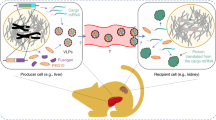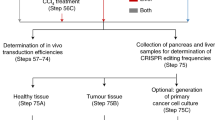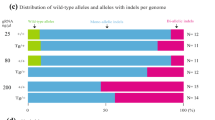Abstract
Preclinical in vivo validation of target genes for therapeutic intervention requires careful selection and characterization of the most suitable animal model in order to assess the role of these genes in a particular process or disease. To this end, genetically engineered mouse models (GEMMs) are typically used. However, the appropriate engineering of these models is often cumbersome and time consuming. Recently, we and others described a modular approach for fast-track modification of existing GEMMs by re-derivation of embryonic stem cells (ESCs) that can be modified by recombinase-mediated transgene insertion and subsequently used for the production of chimeric mice. This 'GEMM-ESC strategy' allows for rapid in vivo analysis of gene function in the chimeras and their offspring. Moreover, this strategy is compatible with CRISPR/Cas9-mediated genome editing. This protocol describes when and how to use the GEMM-ESC strategy effectively, and it provides a detailed procedure for re-deriving and manipulating GEMM-ESCs under feeder- and serum-free conditions. This strategy produces transgenic mice with the desired complex genotype faster than traditional methods: generation of validated GEMM-ESC clones for controlled transgene integration takes 9–12 months, and recombinase-mediated transgene integration and chimeric cohort production takes 2–3 months. The protocol requires skills in embryology, stem cell biology and molecular biology, and it is ideally performed within, or in close collaboration with, a transgenic facility.
This is a preview of subscription content, access via your institution
Access options
Subscribe to this journal
Receive 12 print issues and online access
$259.00 per year
only $21.58 per issue
Buy this article
- Purchase on Springer Link
- Instant access to full article PDF
Prices may be subject to local taxes which are calculated during checkout







Similar content being viewed by others
References
Sato, T. & Clevers, H. Growing self-organizing mini-guts from a single intestinal stem cell: mechanism and applications. Science 340, 1190–1194 (2013).
Vidi, P.A., Bissell, M.J. & Lelievre, S.A. Three-dimensional culture of human breast epithelial cells: the how and the why. Methods Mol. Biol. 945, 193–219 (2013).
Sanchez Alvarado, A. & Yamanaka, S. Rethinking differentiation: stem cells, regeneration, and plasticity. Cell 157, 110–119 (2014).
Takahashi, K. et al. Induction of pluripotent stem cells from adult human fibroblasts by defined factors. Cell 131, 861–872 (2007).
Frese, K.K. & Tuveson, D.A. Maximizing mouse cancer models. Nat. Rev. Cancer 7, 645–658 (2007).
Dranoff, G. Experimental mouse tumour models: what can be learnt about human cancer immunology? Nat. Rev. Immunol. 12, 61–66 (2012).
Couzin-Frankel, J. Breakthrough of the year 2013. Cancer immunotherapy. Science 342, 1432–1433 (2013).
Camacho, L.H. CTLA-4 blockade with ipilimumab: biology, safety, efficacy, and future considerations. Cancer Med. 4, 661–672 (2015).
Huijbers, I.J., Krimpenfort, P., Berns, A. & Jonkers, J. Rapid validation of cancer genes in chimeras derived from established genetically engineered mouse models. Bioessays 33, 701–710 (2011).
Henneman, L. et al. Selective resistance to the PARP inhibitor olaparib in a mouse model for BRCA1-deficient metaplastic breast cancer. Proc. Natl. Acad. Sci. USA 112, 8409–8414 (2015).
Huijbers, I.J. et al. Rapid target gene validation in complex cancer mouse models using re-derived embryonic stem cells. EMBO Mol. Med. 6, 212–225 (2014).
Ivics, Z. et al. Germline transgenesis in rabbits by pronuclear microinjection of Sleeping Beauty transposons. Nat. Protoc. 9, 794–809 (2014).
Cong, L. et al. Multiplex genome engineering using CRISPR/Cas systems. Science 339, 819–823 (2013).
Mali, P. et al. RNA-guided human genome engineering via Cas9. Science 339, 823–826 (2013).
Miller, J.C. et al. A TALE nuclease architecture for efficient genome editing. Nat. Biotechnol. 29, 143–148 (2011).
Ran, F.A. et al. Genome engineering using the CRISPR-Cas9 system. Nat. Protoc. 8, 2281–2308 (2013).
Urnov, F.D., Rebar, E.J., Holmes, M.C., Zhang, H.S. & Gregory, P.D. Genome editing with engineered zinc finger nucleases. Nat. Rev. Genet. 11, 636–646 (2010).
Zhang, F. et al. Efficient construction of sequence-specific TAL effectors for modulating mammalian transcription. Nat. Biotechnol. 29, 149–153 (2011).
Wang, H. et al. One-step generation of mice carrying mutations in multiple genes by CRISPR/Cas-mediated genome engineering. Cell 153, 910–918 (2013).
Yang, H. et al. One-step generation of mice carrying reporter and conditional alleles by CRISPR/Cas-mediated genome engineering. Cell 154, 1370–1379 (2013).
Silva, J. et al. Promotion of reprogramming to ground state pluripotency by signal inhibition. PLoS Biol. 6, e253 (2008).
Ying, Q.L. et al. The ground state of embryonic stem cell self-renewal. Nature 453, 519–523 (2008).
Czechanski, A. et al. Derivation and characterization of mouse embryonic stem cells from permissive and nonpermissive strains. Nat. Protoc. 9, 559–574 (2014).
Hanna, J. et al. Metastable pluripotent states in NOD-mouse-derived ESCs. Cell Stem Cell 4, 513–524 (2009).
Nichols, J. et al. Validated germline-competent embryonic stem cell lines from nonobese diabetic mice. Nat. Med. 15, 814–818 (2009).
Reinholdt, L.G. et al. Generating embryonic stem cells from the inbred mouse strain DBA/2J, a model of glaucoma and other complex diseases. PLoS ONE 7, e50081 (2012).
Premsrirut, P.K. et al. A rapid and scalable system for studying gene function in mice using conditional RNA interference. Cell 145, 145–158 (2011).
Saborowski, M. et al. A modular and flexible ESC-based mouse model of pancreatic cancer. Genes Dev. 28, 85–97 (2014).
van Miltenburg, M.H. & Jonkers, J. Using genetically engineered mouse models to validate candidate cancer genes and test new therapeutic approaches. Curr. Opin. Genet. Dev. 22, 21–27 (2012).
Beard, C., Hochedlinger, K., Plath, K., Wutz, A. & Jaenisch, R. Efficient method to generate single-copy transgenic mice by site-specific integration in embryonic stem cells. Genesis 44, 23–28 (2006).
Premsrirut, P.K., Dow, L.E., Park, Y., Hannon, G.J. & Lowe, S.W. Creating transgenic shRNA mice by recombinase-mediated cassette exchange. Cold Spring Harb. Protoc. 2013, 835–842 (2013).
Fu, Y. et al. High-frequency off-target mutagenesis induced by CRISPR-Cas nucleases in human cells. Nat. Biotechnol. 31, 822–826 (2013).
Hsu, P.D. et al. DNA targeting specificity of RNA-guided Cas9 nucleases. Nat. Biotechnol. 31, 827–832 (2013).
Pattanayak, V. et al. High-throughput profiling of off-target DNA cleavage reveals RNA-programmed Cas9 nuclease specificity. Nat. Biotechnol. 31, 839–843 (2013).
Smith, C. et al. Whole-genome sequencing analysis reveals high specificity of CRISPR/Cas9 and TALEN-based genome editing in human iPSCs. Cell Stem Cell 15, 12–13 (2014).
Veres, A. et al. Low incidence of off-target mutations in individual CRISPR-Cas9 and TALEN targeted human stem cell clones detected by whole-genome sequencing. Cell Stem Cell 15, 27–30 (2014).
Mali, P. et al. CAS9 transcriptional activators for target specificity screening and paired nickases for cooperative genome engineering. Nat. Biotechnol. 31, 833–838 (2013).
Ran, F.A. et al. Double nicking by RNA-guided CRISPR Cas9 for enhanced genome editing specificity. Cell 154, 1380–1389 (2013).
Lloyd, K., Franklin, C., Lutz, C. & Magnuson, T. Reproducibility: use mouse biobanks or lose them. Nature 522, 151–153 (2015).
Dow, L.E. et al. Conditional reverse tet-transactivator mouse strains for the efficient induction of TRE-regulated transgenes in mice. PLoS ONE 9, e95236 (2014).
Dow, L.E. et al. A pipeline for the generation of shRNA transgenic mice. Nat. Protoc. 7, 374–393 (2012).
Kiyonari, H., Kaneko, M., Abe, S. & Aizawa, S. Three inhibitors of FGF receptor, ERK, and GSK3 establishes germline-competent embryonic stem cells of C57BL/6N mouse strain with high efficiency and stability. Genesis 48, 317–327 (2010).
Tamm, C., Pijuan Galito, S. & Anneren, C. A comparative study of protocols for mouse embryonic stem cell culturing. PLoS ONE 8, e81156 (2013).
Liang, Q., Conte, N., Skarnes, W.C. & Bradley, A. Extensive genomic copy number variation in embryonic stem cells. Proc. Natl. Acad. Sci. USA 105, 17453–17456 (2008).
Pettitt, S.J. et al. Agouti C57BL/6N embryonic stem cells for mouse genetic resources. Nat. Methods 6, 493–495 (2009).
Bin Ali, R. et al. Improved pregnancy and birth rates with routine application of nonsurgical embryo transfer. Transgenic Res. 23, 691–695 (2014).
te Riele, H., Maandag, E.R. & Berns, A. Highly efficient gene targeting in embryonic stem cells through homologous recombination with isogenic DNA constructs. Proc. Natl. Acad. Sci. USA 89, 5128–5132 (1992).
Heiman, M. et al. A translational profiling approach for the molecular characterization of CNS cell types. Cell 135, 738–748 (2008).
Krimpenfort, P. et al. p15Ink4b is a critical tumour suppressor in the absence of p16Ink4a. Nature 448, 943–946 (2007).
Solter, D. & Knowles, B.B. Immunosurgery of mouse blastocyst. Proc. Natl. Acad. Sci. USA 72, 5099–5102 (1975).
McFarlane, L., Truong, V., Palmer, J.S. & Wilhelm, D. Novel PCR assay for determining the genetic sex of mice. Sex. Dev. 7, 207–211 (2013).
Hogan, B., Beddington, R., Costantini, F. & Lacy, E. Manipulating the mouse embryo. 2nd edn. (Cold Spring Harbor Laboratory Press, 1994).
Wong, K. et al. Sequencing and characterization of the FVB/NJ mouse genome. Genome Biol. 13, R72 (2012).
Yalcin, B., Adams, D.J., Flint, J. & Keane, T.M. Next-generation sequencing of experimental mouse strains. Mamm. Genome 23, 490–498 (2012).
Yalcin, B. et al. The fine-scale architecture of structural variants in 17 mouse genomes. Genome Biol. 13, R18 (2012).
Meuwissen, R. et al. Induction of small cell lung cancer by somatic inactivation of both Trp53 and Rb1 in a conditional mouse model. Cancer Cell 4, 181–189 (2003).
Jackson, E.L. et al. Analysis of lung tumor initiation and progression using conditional expression of oncogenic K-ras. Genes Dev. 15, 3243–3248 (2001).
Jongsma, J. et al. A conditional mouse model for malignant mesothelioma. Cancer Cell 13, 261–271 (2008).
Liu, X. et al. Somatic loss of BRCA1 and p53 in mice induces mammary tumors with features of human BRCA1-mutated basal-like breast cancer. Proc. Natl. Acad. Sci. USA 104, 12111–12116 (2007).
Derksen, P.W. et al. Mammary-specific inactivation of E-cadherin and p53 impairs functional gland development and leads to pleomorphic invasive lobular carcinoma in mice. Dis. Model Mech. 4, 347–358 (2011).
Acknowledgements
This work was supported by grants from the Dutch Cancer Society (KWF), the Netherlands Organization for Scientific Research (NWO) and the European Research Council (ERC), by a National Roadmap grant for Large-Scale Research Facilities provided by NWO, by the Cancer Systems Biology Center funded by NWO and by the EuroSyStem, Infrafrontier and EurocanPlatform projects as part of the European Union's seventh framework program. We thank J. Nichols and A. Smith (Wellcome Trust Centre for Stem Cell Research) for introducing us to their ESC derivation and ESC culture procedures, which form the basis for this protocol. We thank R. Jaenisch (Whitehead Institute for Biomedical Research) for the Flp-in plasmids. We thank F. van der Ahé, M. Cozijnsen and S. Kautschitsch for their excellent technical assistance; M. Snoek for the official MGI nomenclature; the Genomics Core Facility for their assistance in CNV analysis; and the Infrafrontier consortium headed by M. Hrabé de Angelis for providing a platform to distribute GEMM-ESC clones.
Author information
Authors and Affiliations
Contributions
I.J.H. developed the protocol. J.D.B., R.B.A., C.P. and E.M.M. contributed to and supported the development of the protocol. T.M.B., M.H.v.M. and L.H. expanded the protocol and generated the unpublished GEMM-ESC clones in Table 1. I.J.H., A.B. and J.J. designed the study and wrote the manuscript.
Corresponding authors
Ethics declarations
Competing interests
The authors declare no competing financial interests.
Rights and permissions
About this article
Cite this article
Huijbers, I., Del Bravo, J., Bin Ali, R. et al. Using the GEMM-ESC strategy to study gene function in mouse models. Nat Protoc 10, 1755–1785 (2015). https://doi.org/10.1038/nprot.2015.114
Published:
Issue Date:
DOI: https://doi.org/10.1038/nprot.2015.114
This article is cited by
-
INFRAFRONTIER: mouse model resources for modelling human diseases
Mammalian Genome (2023)
-
Truncated FGFR2 is a clinically actionable oncogene in multiple cancers
Nature (2022)
-
Recent advances in preclinical models for lung squamous cell carcinoma
Oncogene (2021)
-
A mouse model that is immunologically tolerant to reporter and modifier proteins
Communications Biology (2020)
-
Effective CRISPR/Cas9-mediated correction of a Fanconi anemia defect by error-prone end joining or templated repair
Scientific Reports (2019)
Comments
By submitting a comment you agree to abide by our Terms and Community Guidelines. If you find something abusive or that does not comply with our terms or guidelines please flag it as inappropriate.



